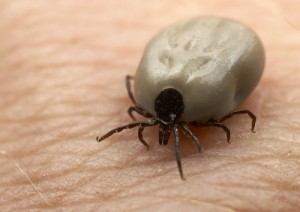
Photo courtesy of the County of San Diego.
Fiction: Tick populations die during the winter.
Fact: Ticks aren’t as active during cold months, but they don’t die. They still can attach to companion animals and transmit pathogens.
Fiction: If ticks aren’t observed on the companion animal, there are no ticks in the area.
Fact: Three tick life stages can attach to companion animals: nymph, larva and adult. Usually, they’re recognized only if many are
present, or feeding has allowed engorgement. Most infestations are unrecognized.
Fiction: Remove ticks using alcohol, petroleum jelly, nail polish or a lit match.
Fact: Using tweezers, grasp the tick as close to the surface of the skin as possible. To remove the tick, softly and steadily pull in the reverse direction of the tick’s body. This motion avoids the risk of pathogen transmission.
Fiction: Veterinary medications are ineffective.
Fact: Complete effectiveness sometimes isn’t plausible. However, if a companion animal encounters 100 ticks while being treated with a
99% effective product (an excellent veterinary standard), only one tick remains.
Dr. Mitchell, D.O., Ph.D., M.P.H., B.C.E., a board-certified physician and entomologist, is principal technical specialist for PestWest Environmental, as well as PMP’s Technical Editor. He can be reached at docmitchell@northcoastmedia.net or 515-333-8923.
Leave A Comment